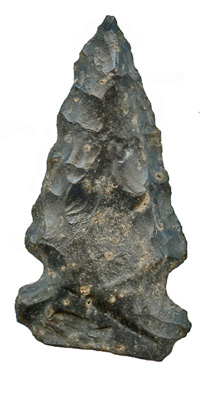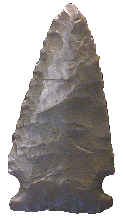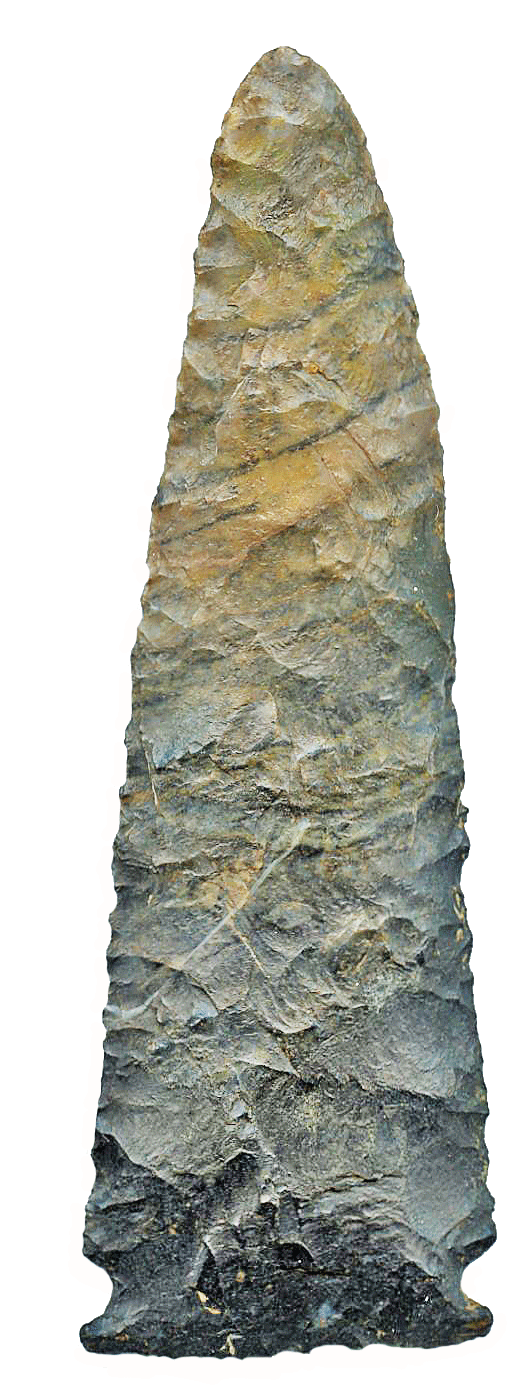





Point Type: MEADOWOOD
Also See: Big Sandy, Big Sandy Broad Base, Davis, Godar,
Hemphill, Hodges, Hunt, Osceola, Otter Creek
Location: Northeastern United States
Associated Dates:
4000 - 2000 B.P. - Woodland
Morphology: Side
Notched
General Description: The Meadowood type is a very thin, medium to large sized, broad, side notched point. The notches occur very close to the base. The blade is trianguloid in outline, flat in cross section with straight edges that can range from slightly excurvate to slightly incurvate and are occasionally serrated or deeply beveled from opposing sides. The stem is very short and is neatly side notched, sometimes with a double notch. The base is usually straight but can be slightly convex and on some examples can be expanding into a fan shape. The base is ground smooth on about fifty percent of examined specimens. Unfinished or unnotched blades are often found in caches.
The point is found primarily in New York and surrounding states (east into Massachusetts, Connecticut and Vermont and south into the upper Delaware, west into northwestern Pennsylvania, northern Ohio, northeastern Indiana, northeastern Illinois, southern Michigan and southeastern Wisconsin) including southeastern Ontario. The point is diagnostic of the Early Woodland Meadowood phase in the Northeast (Ritchie & Funk 1973:116)
In New York, these points were typically made from a mottled gray and brown flint from the Onondaga region of western New York and the Ontario Peninsula or the clear gray flints of the central New York Onondaga escarpment. In Ohio, Upper Mercer gray flint and black varieties are common. Indiana Hornstone and Carter Cave flint are only occasionally seen as are Delaware and Logan County cherts.
The size of the Meadowood point can range from 41 mm to 89 mm in length with the typical point being in the 63 mm range. The average thickness rarely exceeds 5 mm. The Meadowood point type was named by William A. Ritchie for specimens he found near Meadowood, New York.
About The Point Above
(Left): The small Meadowood point pictured at the top left hand
side of this page, was found on the old Forbes Farm site along the
Connecticut River in East Hartford, Connecticut. It is made from pure dark
blackish Onondaga flint material which has some speckles of gray in it. Overall,
the point measures 35 mm in length, is 17 mm wide above the notches
and is 6.5 mm thick at mid blade near the shoulders. The base measures 18.4
mm in width and the stem is 10 mm long. The point has been reworked. The edges are quite sharp and have just a slight hint of
serration. The point's base is asymmetric. There is a slight amount of
basal grinding on this point. Catalog Number 427-13-C
About The
Point Above (Center):
About The Point Above (Right): The very large classic example of a Meadowood spear point or knife blade pictured at the top right of this page. The specimen was found in a cornfield drainage washout in the town of Gallipolis, Gallia Co, Ohio. It is made from a glossy flint material which banded tan (near the tip) and blackish gray. Overall, the point measures a whopping 111 mm in length, is 36 mm wide above the notches and is 10.3 mm thick at 50 mm from the base and 6 mm thick in the tip area. The base measures 36 mm in width and the stem is 9 mm long. The point tip appears to have been historically reworked. The blade edges are still quite sharp and have just a slight hint of serration. The overall workmanship and fine pressure flaking are marvelous. There is a slight amount of basal grinding on this point. There is some amount of encrustation on parts of the blade, especially near the halfting area. Catalog Number 207-250-N
References: Converse, Fogleman, Justice, Overstreet, Ritchie
© Copyright 1997 - 2008 LITHICS-Net WWW.LITHICSNET.COM
Use your Browser's BACK Button to return to the LITHICS-Net Index.